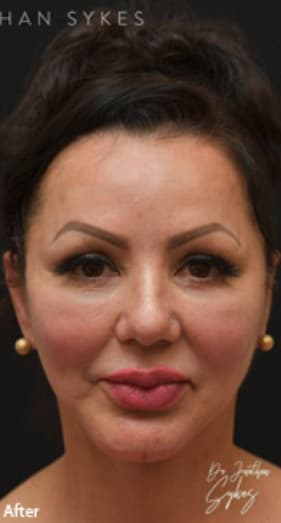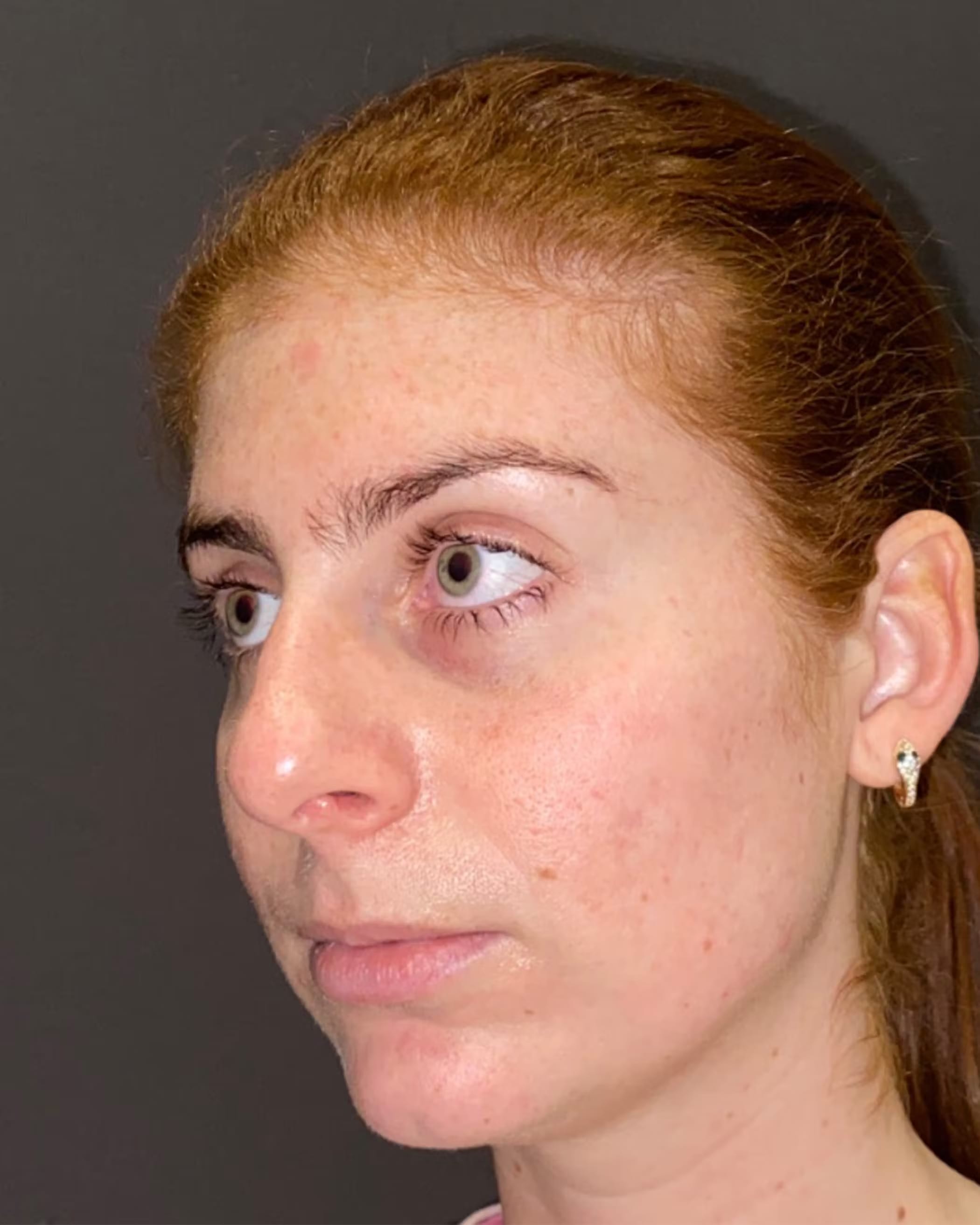
The Skinny
Types of Chin Enhancement Procedures
According to the American Academy of Facial Plastic and Reconstructive Surgery, plastic surgery on the chin is called mentoplasty or genioplasty. Facial plastic surgery can have a huge impact on the appearance and function of the chin. It can also help improve the look of other facial features.
A chin that is too large or too small can warp the perception of different facial features. For instance, a reduced or "weak chin" may make a person's nose appear too large. On the contrary, an outsized chin can cause the eyes and nose to be perceived as too small.
Chin surgery is a surgical procedure that can greatly change an individual's appearance. Receiving a chin implant or chin reduction surgery, which affects the chin bone, according to the American Society of Plastic Surgeons, can improve the patient's confidence and self-esteem.
According to the 2017 Cosmetic Plastic Surgery Statistics of Cosmetic Procedure Trends by the American Society of Plastic Surgeons, there were 16,136 chin augmentation procedures performed in 2017. The report states that 16,688 of the same facial procedures were undergone in 2016. In 2000, there were 26,924 chin surgeries.
Comparing chin surgery to other procedures, it is noteworthy to learn that while chin surgeries are not performed as frequently as a surgeon may perform cosmetic surgery on other parts of the body, the impact that a mentoplasty has on the patient’s self-esteem can be just as dramatic.
For instance, there were 23,433 ear surgery procedures in 2017, down 1% from the 23,709 otoplasty surgeries performed in 2016, and down 35% from the 36,295 ear surgeries in 2000. Much more popular than chin surgeries include procedures such as breast augmentation surgeries, with 300,378 procedures performed in 2017. Breast lift surgeries were performed 105,219 times in 2017, while breast reduction procedures took place 43,635 times that same year.
There are many different ways to improve the look of the chin - beyond silicone implants to correct a chin deficiency - including the use of dermal fillers. A plastic surgeon might use fillers to improve the chin area in certain patients who aren't ready for the rigors of chin surgery. Or, a plastic surgeon might suggest chin surgery when certain patients request a nose job, to ensure the chin shape and position complements the perceived size of the nose.
According to Regents of the University of Michigan, chin surgery can also include the correction of a cleft chin, which is a chin that has a dimple in the middle. The following are a variety of ways that a chin can be enhanced.
AEDIT
Before & After Images by Provider












Before & After Images by Provider
Chin Surgery (Mentoplasty) Solutions
The Specifics
The Cost of Chin Surgery
How much does surgery for the chin cost? The cost to correct issues with the chin can vary quite a bit, based upon the type of procedure being used to make the corrections. The American Society of Plastic Surgeons placed the average price of surgery for the chin at $2,236, based on 2017 statistics.
However, when seeking a surgical solution to any of your issues with your chin, it helps to learn the best type of procedure for your problems, as well as all the costs included or excluded from what you have been quoted during your consultation. For example, the $2,236 average cost listed by the ASPS does not include expenses such as the surgeon's fee, any costs of general or local anesthesia, or costs associated with the hospital or surgical facility where your surgery is performed. Include the costs of any exams to determine your medical condition, along with post-operative medications and garments, when calculating the total expenditures to be paid for your surgery.
Cost Based on Type of Chin Procedure The specific type of chin procedure dictates the cost. Implants in the chin, according to the American Society of Plastic Surgeons (ASPS), may cost $2,225 for the facial implants garnered in the United States. Implants in the chin may range in price as low as $650 up to $10,250, with the average cost at $4,525.
Most medical insurance plans will not cover the cost of surgery on the chin if it is for cosmetic purposes. However, if the surgical procedure for the chin has been undergone to correct a birth defect, a traumatic injury, or some similar situation, the insurance carrier might reimburse some or all of the procedure costs. Verify with your insurance company before the surgery how much - if any - of the cost they will cover.
Before & After Chin Surgery
Before undergoing a surgical procedure for your chin, it is important to search for a board-certified plastic surgeon to perform the surgery. Be sure to find a doctor that is credentialed and makes you feel comfortable, even if that requires travel to another city such as New York or Los Angeles.
Starting with a consultation, you will be able to learn all the intricate details about the chin treatment that would help your case. The consultation should include disclosure of any risks, side effects, and potential complications of the procedure. The physician may order an X-ray so that they can determine the underlying structure of your chin, and how it can best be reshaped to meet the surgical outcome you desire.
In the wake of your consultation - but before your surgery - your physician should supply you with a list of pre-operative instructions to help you prepare for your procedure. Those instructions may include information about quitting smoking and abstaining from taking any medications, aspirin, or supplements that cause your blood to thin before surgery.
Enlist a friend, family member, or a professional service to drive you home after the surgical procedure. Plan to have someone assist you for at least 24 hours at home during your recovery period.
Combining Surgeries
Often, when a person decides to get surgery or a non-invasive procedure performed on their chin to improve their self-esteem and overall facial appearance, it isn't the only treatment they want to receive.
Speak with your surgeon during your consultation about any other types of surgical procedures you are considering, because combining select plastic surgery procedures is not only practical - it can save time and money. For example, surgery on the chin is often done in conjunction with nose surgery, a neck lift, laser skin resurfacing, or other procedures that have an impact upon a person's outlook. It is common that eyelid surgery is also often combined with surgery on the chin.
Patients may take advantage of going under anesthesia and taking time off of work to recover from surgery to get additional facial surgery procedures done. Therefore, surgeries to lift the eyebrows, a facelift, fat injections, neck liposuction, and a plethora of other procedures are often done at the same time as surgery for the chin.
The cost of surgery for the chin may be reduced when experienced simultaneously with other procedures, since fees for anesthesia, the surgical facility, as well as the surgeon's fee likely won't have to be paid separately, as in the case of having the surgeries during different occasions.
1: Chin Augmentation (Chin Implants)
When discussing various types of procedures to correct the chin, augmentation of the chin with an implant is the most popular type of chin surgery. Plastic surgeons utilize implants to create contour and volume for a chin that is recessed or lacks projection.
The implants can be made of synthetic material, silicone, bone, and other substances. The plastic surgery works best for healthy adults who solely have a concern about the smaller size of their chin. If a patient is worried about other concerns, such as the shape of their jaw or a problem with the positioning of their teeth, a chin implant alone may not be the answer.
However, those merely focused on a chin that is too small may benefit from an implant that provides the projection and definition desired. The surgeon must inform the patient that chin augmentation will not improve chin deformities that are better served by orthognathic surgery, which is jaw surgery that corrects problems with the jaw bones and teeth.
Chin implant surgery involves an incision beneath the chin or in the interior portion of the lower lip. The implants are placed into the space created via the incision, with certain chin implants being affixed to the jawbone itself while other implants remain in the pocket made during surgery.
2: Chin Augmentation with Fat Transfer or Soft Tissue Fillers
Enhancing the chin with soft tissue fillers or via a fat transfer is another option, although it isn't permanent plastic surgery like an implant. Getting chin fillers means there are no surgical incisions and shorter recovery time, but the process is temporary.
With fillers containing hyaluronic acid (HA) or other substances injected into the chin, patients can obtain a natural look of projection that may last as long as two years. A new chin in five minutes is possible with dermal fillers, as seen in videos of the procedure.
Chin fillers via a fat transfer are also possible, with the benefit of the fat coming from the patient's body having a low rate of rejection and a retention rate of 20% to 80%. However, there is still the risk of postoperative problems occurring from where the fat was harvested.
3: Chin Ptosis Correction Surgery
Chin ptosis or "witch's chin" is the common name for a chin that might be projected quite a bit, with a deep fold, or sagging skin. When a person smiles, the condition can be more pronounced. Local anesthesia is used during the surgery that creates an incision to correct the projection of the chin.
Chin ptosis that stems from inherent issues with the facial bone structure will require surgical correction that involves osteotomies, or bone cuts. Patients needing this surgery should have not had periodontal disease to ensure the best results as permanent anchors will be positioned above the jawbone's lower border to elevate the chin's soft tissue. Other times, only excess skin or fat may be removed to improve the projection of the chin. An implant may also be placed during surgery to ensure ideal face proportions for the patient.
4: Chin Reduction Surgery
Chin reduction surgery helps people with large chins balance their facial features. The surgery takes approximately one hour and involves using general anesthesia. Incisions are made under the chin and inside the mouth to separate the skin from the chin bone to allow extra tissue and bone to be removed.
The skin of the chin may also be repositioned and an implant potentially used to smooth away any angular or rough edges. The chin bone is usually shaved down to create a more feminine or balanced look. Ideal candidates for chin reduction surgery include healthy adults whose chin is no longer growing and those who do not suffer from periodontal disease.
5: Sliding Chin Osseous Genioplasty Surgery
Sliding genioplasty is a form of chin surgery that can either augment or reduce the size of the chin. During an augmentation, a portion of bone that is shaped like a horseshoe will be cut from the lower jaw and moved forward for greater chin projection. In the case of chin reduction surgery, the same portion of bone can be placed farther back. Titanium screws and a titanium plate hold the bone in place.
Also called osseous genioplasty, the surgery is recommended for people who have a chin that projects very far forward or very far back. In the case of chin reduction with this surgery, portions of bone may be removed while the patient is under general anesthesia.
6: Jaw Implants
Facial implants such as jaw implants usually help individuals who have small or unbalanced jawbones correct them via surgery that enhances their jawline. Incisions are generally created inside the back of the mouth near the juncture of the cheeks and gums to put the jaw implant in place.
Jaw implants are usually comprised of MEDPOR®, which is a type of biocompatible implant material made of porous polyethylene. The material allows individuals who desire strong jawlines to create a more angular, natural-looking face shape after undergoing the procedure.
The MEDPOR® implant will adhere to the jaw bone, allowing for a more stable and secure outcome than silicone materials. The titanium screws secure the implant in place and all incisions are closed via several layers so that fluids from the mouth will not seep into the incision. The surgery may last from one to two hours.
7: Double Chin Correction
When certain individuals speak about problems with their chin, it isn't necessarily a weak chin nor a sagging chin that is the issue. Instead of issues with the actual chin bone, some patients have a problem with a double chin, which can be treated by options that aren't as invasive as chin surgery.
Body contouring via laser treatments can help reduce the appearance of a double chin, such as procedures like SculpSure®, which has received clearance from the FDA to treat excess fat, tissue, and skin beneath the chin. Whereas a double chin can mask the jawline, treatment sessions with the laser can help to eliminate the fat below the skin, eventually destroying those fat cells. The procedure may last approximately 25 minutes, but it can take up to six weeks for the body to naturally eliminate the destroyed fat cells.
Although the process can include side effects such as burning, bruising, and stinging, the procedure to treat double chins is not invasive and doesn't require much downtime or recovery. Other methods of treating a double chin include the injectable Kybella®, which is FDA approved to help reduce fat under the chin and neck.
Recovery from Chin Surgery
The recovery period for a chin procedure is also dependent upon whether or not you received an invasive surgery or a non-invasive treatment. Either way, it is essential to follow the specific post-surgery procedures given by the surgeon to help the healing process flow smoothly.
Keeping every follow-up appointment is also important in the wake of surgery to help your physician ensure the recovery process is proceeding as planned. Expect the following recovery times based upon the procedure being received:
Jaw implant surgery may include a follow-up appointment after one or two weeks to remove any non-dissolvable stitches, with the entire recovery process lasting from three weeks to nine months
Surgery to place implants in the chin may come with a recovery period as little as one week up to three months
Dermal fillers injected into the chin requires a very short recovery period, lasting from two to 10 days
Chin ptosis correction may be accompanied by a recovery period of one to three weeks
Surgery for reduction of the chin comes with a recovery period that can last from two weeks to six months
A sliding chin surgical procedure may take anywhere from six weeks to six months to recover from
Patient care after most surgical procedures for the chin involves adapting to actions that help the chin and jaw heal. That includes eating a soft food diet that doesn't aggravate the surgical incisions. Patients might experience a tight feeling that ultimately goes away during the recovery period.
Most surgeries for the chin are outpatient procedures that are performed with the surgeon utilizing general anesthesia or local anesthesia with sedation on the patient. The small incisions that are created below the chin or within the mouth will likely feel tender or sore. Pain medication can be used to alleviate any feelings of discomfort, and surgical dressing will likely be worn for two or three days following surgery.
Whereas the chin area may be exaggerated with swelling initially, expect the swelling to reduce after six weeks post-surgery. Your doctor may advise you to stay away from strenuous activity such as intense exercise during the initial one or two weeks after your surgical procedure. However, you should be able to resume your normal activity about 10 days after your procedure.
The Takeaway
Finding a Surgeon
All in all, no matter the specific form of cosmetic surgery you are seeking to correct issues with the shape or size of your chin, it is essential to find a plastic surgeon or practitioner who enjoys extensive experience in helping patients via facial surgery procedures similar to yours.
Make sure to contact several providers and engage in multiple consultations until you feel comfortable with the practitioner you select to perform your chin procedure. The professional should be able to demonstrate their capabilities by showing you before-and-after photos of the real-life patients that have been helped via chin procedures. If you are unsure of how you will look with chin alterations, get digital samples of how your face may appear after chin surgery or seek to have dermal fillers injected into your chin first if you are thinking of getting a chin implant or surgery to alter your chin's projection.


